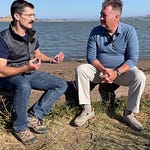In this conversation with Elizabeth Chabe, CEO of High Touch Group and author of The Giant's Ladder: The Science Professional’s Blueprint for Marketing Success, we discussed a possible convergence between science communication and marketing. Reflecting on how few living scientists are household names, she talked about the importance of storytelling in transforming scientists into figures society admires even positioning them as rockstars or cultural icons.
Their lack of visibility isn’t because scientists aren't engaging but because the traditional academic outlets they utilize don’t effectively reach the wider public. She sees an opportunity for scientists to break free from academic journals and allow their work to inspire future scientists and communicate value to society. Elizabeth noted the healthcare sector's medical affairs professionals, who engage deeply with scientific education yet seldom achieve fame comparable to cultural figures like Neil deGrasse Tyson or Bill Nye.
The challenge, she says, lies in leveraging modern marketing tools to amplify these efforts effectively. We talked about how platforms, including YouTube, offer avenues for better engagement with the public and how scientists, through storytelling and proper marketing strategies, can expand their reach.
Not subscribed? Let’s fix that, shall we? Subscribe for free to receive new posts and support my work.
What does this mean for companies? You might say that science is a little bit on the back foot lately. There is a definite issue of trust even as more and more of our daily lives are made better and more convenient by the discoveries of scientists. This is a topic that has been on my mind a lot lately.
Companies have an opportunity, and I would argue an obligation, to elevate both their brand and society’s perception of science. Elizabeth provided examples of organizations like Moderna. During the COVID-19 pandemic, Moderna focused on its broader mission of advancing RNA-based medicine. This strategic focus not only strengthened their brand but also helped reinforce trust in RNA-based therapeutics. That has likely opened up a whole new world of possible therapies but without trust, will they make it to market?
Finally, where are the lines between science communication, education, and marketing and how can companies think about these activities to grow their business and, if you will, the market for science and scientific advances?
Elizabeth has a framework for thinking about the nuances that I really appreciate. This segmentation—communication explains, education equips, and marketing connects—provides a foundational strategy for life science companies to build trust and competence and ultimately motivate action.
Science communication is about making information digestible for non-experts, education builds understanding and competence, while marketing’s goal is to foster an emotional connection and drive action.
Thinking long term, science communication not only helps the public to appreciate the work you do now, but feeds a pipeline to solve problems, possibly at your company, in the future. Education naturally follows to make that happen. As marketers we should take advantage of all of the above to create those connections, build our brands and create a public that accepts science, not blindly, but with real understanding.
Your deepest insights are your best branding. I’d love to help you share them. Chat with me about custom content for your life science brand. Or visit my website.













